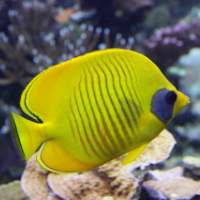Characteristics
Butterflyfishes, conspicious as they are, come in almost all colors of the rainbow. Their presence in the Red Sea ensures a fascinating panorama of stunning coral reefs and vibrant fish life. Some species from this family are endemic. It means they are spotted only in their peculiar Red Sea habitat and nowhere else.
Butteflyfishes are equipped with what is called a continious dorsal fin. They are classified as typical diarnul, meaning they are active during the day. They find food and shelter, depending on terrotorial coral formations. Throughout their evolution, they have developed a flattened shape, enabling them to easily criss-cross coral labyrinths.
Butterflyfishes enjoy a very varied diet. The majority of butterflyfishes feed on polyps, algae, tiny invertebrates and fish eggs. Many of these fish are generalists, operating in schools, alone, small groups or as couples. Their fantastic coloration is multi-purpose. The variety allows them to recognize each other and ‘communicate’ with each other and tell the difference between young species and adults. It also helps them to mislead predators. The hotchpotch of spots, stripes and bands make them look like either formless, two-headed or even ‘broken up’.
The length of a butterflyfish varies from 6 to 30 centimeters. Their flattened shape conjures up visions of a ‘disk’ profile. They have what is called a proctractile or protrusible mouth, equipped with small, sharp teeth. The Chaetodontidae family name derives from ancient Greek words, meaning ‘bristle teeth’.
Male butterflyfish have a tendency to be monogamous, meaning they favor ‘long term mates’ in a lifelong stable relation. Interesting of note is the lined butterflyfish. This species, either solitary or living in couples, is aggressive with other fish, in contrast to the majority of other members of the Chaedotontidae family.
Species
- Endemic
- Crown butterflyfish
- Diagonal butterflyfish
- Exquisite butterflyfish
- Hooded butterflyfish
- Masked butterflyfish
- Orangehead butterflyfish
- Striped butterflyfish
Crown Butterflyfish
The crown butterflyfish lives in pairs or in small groups between 4 meters and 30 meters, preferably near underwater meadows. The red rear is very distinctive; yet its key identification is the reddish-yellow stripe covering the eye. The crown butterflyfish measures 14 centimeters in length and likes to hang around hard corals: an abundance of these fish indicates good hard coral coverage on the seabed. When scarce in presence in a previously abundant area, it signals that the coral may be in trouble.
Diagonal butterflyfish
The diagonal butterflyfish, also known as the Red Sea raccoon butterflyfish is found in the Red Sea only. Its body is predominantly yellow, marked with black spots and black diagonal stripes. The diagonal butterflyfish can reach a maximum length of 22 centimeters. The like to hoover over corals to feed themselves, predominantly restricted to their native habitat.
Exquisite Butterflyfish
The exquisite butterflyfish or blacktail butterflyfish measures up to 12 cm in length and is mainly yellow with thin, curved black stripes. Its anal fin and tail are black. The body of juveniles is whiter above with white bands on the tail. Exquisite butterflyfish graze on coral polyps and anemone tentacles. Adults are generally found in pairs, patrolling their territory, while juveniles are predominantly found among coral branches.
Hooded Butterflyfish
The hooded butterflyfish is classified as an endemic Red Sea fish, but as of 2011 sightings have been recorded in the southeast of the Mediterranean Sea. It normally grows to a maximum of 12 centimeters long and enjoys aqautic life at depths between 3 meters and 12 meters. The flattened body is colored powder blue, mixed with white chevron-shaped bars. The head is bright red-orange.
The hooded butterflyfish can be found swimming in pairs, mostly in shallow lagoons or over staghorn coral plates, feeding themselves with their polyps. They are classified as territorial.
Masked Butterflyfish
The masked butterflyfish, also known as the bluecheek butterflyfish, measures up to 23 centimeters and feels very comfortable at depths between 3 and 20 meters. Its colorisation tends to orange-yellowish, decorated with fine dark diagonal stripes. The eyes are encircled by dark blue markings, hence the name ’masked‘. The masked butterflyfish is often found in schools in areas where there is rich coral growth. It is occasionally observed hovering in a stationary position for extended periods under ledges of staghorn coral plates.
Orangehead Butterflyfish
The orangehead butterflyfish, its maximum length 12 centimeters, is also peculiar to the Red Sea and roams around staghorn plates, feeding on its coral polyps. She is active during the day, moving in couples, preferably at depths of 12 meters.
The orangehead butterflyfish has an odd shaped, square-like profile. It has an intriguing light blue colored body, black dorsal and caidal fins and an orange-reddish head.
Striped butterflyfish
This endemic species has a compressed yellow body, marked with black diagonal stripes. Measuring up to 22 centimeters, its eyes are masked with black dots.
Striped butterflyfish operate in couples or small groups in shallower habitats that are rich in coral presence, reaching depths until 25 meters. On its menu are algae and invertebrates.
Red Sea bannerfish
One other species deserving mentioning and belonging to the family of Chaetodontidae is the bannerfish, more specifically the Red Sea bannerfish.
This bannerfish is also endemic to the Red Sea. Its maximum length is 20 cm and can be spotted at depths between 3 meters and 50 meters. Its square body carries a very long ray on its dorsal fin. The body features white and yellow colorings and two black diagonal bands. The Red Sea bannerfish’s menu consists of invertebrates. Young species are sociable and gregarious, meaning they like company in bigger numbers. The adults however stick to their territory and like to form couples only.
- Non-endemic
- Arabian butterflyfish
- Blackbacked butterflyfish
- Chevron butterflyfish
- Lined butterflyfish
- Paleface butterflyfish
- Threadfin butterflyfish
- Whiteface butterflyfish



